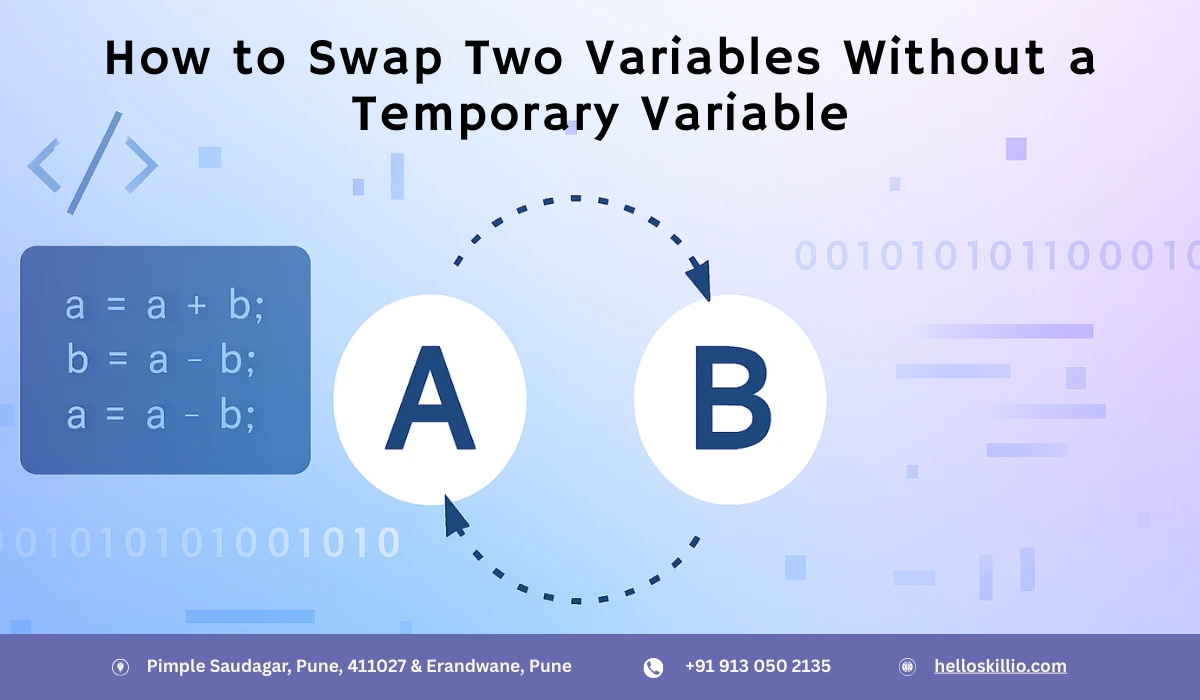Swapping two variables is one of the most common operations in programming. Whether you are learning to code for the first time or preparing for technical interviews, understanding multiple ways to swap variables without using a temporary placeholder can greatly strengthen your problem-solving skills.
In traditional programming, swapping values involves using an extra variable that acts as storage. But what if you want to swap values without a third variable? This is where your logical thinking and understanding of number manipulation truly shine.
In this comprehensive guide, we’ll explore various techniques to swap two variables without using a temporary variable. We’ll also look at the pros and cons of each method, the best use-cases, and how these techniques apply in the real world. If you’re aiming to sharpen your coding fundamentals, this tutorial will serve as a perfect starting point.
Why Learn How to Swap Variables Without a Temporary Variable?
Swapping without a temporary variable is not just a coding trick—it teaches you:
- Logical reasoning
- Memory optimization
- Understanding of low-level operations
- Mathematical and bitwise manipulation
These techniques often appear in:
- Coding interviews
- Competitive programming
- System-level programming
- Algorithm design
- Embedded systems
Even though modern programming languages handle memory efficiently, mastering these fundamentals can set you apart as a more confident and efficient developer.
Basic Example of Swapping With a Temporary Variable
Before we dive into swapping without a temp variable, here’s the traditional method for clarity:
a = 10
b = 20
temp = a
a = b
b = temp
This uses extra storage, which is sometimes not preferred—especially in memory-constrained environments.
Methods to Swap Two Variables Without a Temporary Variable
Below are the most popular and reliable techniques used by programmers around the world.
1. Using Addition and Subtraction
This is one of the oldest and simplest ways to swap variables without using extra memory.
How It Works
a = 10
b = 20
a = a + b # a = 30
b = a – b # b = 10
a = a – b # a = 20
Why It Works
You combine the values in a single variable and extract them back using arithmetic operations.
Pros
- Easy to understand
- Works in most programming languages
- No temporary variable needed
Cons
- Can cause integer overflow with very large numbers
- Limited to numeric data types only
Best Use Case
Use this method when the numbers are small and within safe limits for your programming language.
2. Using Multiplication and Division
This method also eliminates the need for temporary storage.
Example
a = 10
b = 20
a = a * b # a = 200
b = a / b # b = 10
a = a / b # a = 20
Limitations
- Not suitable when either variable is zero
- Can cause overflow or precision issues
- Mostly applicable only to integer values
While it’s good for understanding, this technique is not recommended for production code.
3. Using XOR (Bitwise Operator)
Swapping using XOR is considered one of the most efficient and elegant methods.
How It Works
a = 10
b = 20
a = a ^ b
b = a ^ b
a = a ^ b
Why Developers Love This Method
- No overflow
- No extra storage
- Works perfectly for integers
- Very fast in execution
Cases Where XOR Is Ideal
- Low-level programming
- Embedded systems
- Competitive coding
- System programming where performance matters
Drawbacks
- Only works with integers
- Not intuitive for beginners
4. Pythonic Way (Tuple Packing and Unpacking)
Python offers an elegant and easy method to swap variables in just one line.
Example
a = 10
b = 20
a, b = b, a
Advantages
- Most readable
- Clean syntax
- No arithmetic or bitwise operations
- No risk of overflow
When to Use
Perfect for Python programming, professional codebases, and beginner-friendly learning.
5. Using Bitwise Addition Without Overflow (Advanced Concept)
Some languages support safe bitwise addition to avoid overflow.
Example concept: Using bitwise operations like AND, OR, SHIFT, though not typically used for variable swapping, can be adapted for memory-safe arithmetic.
This is more theoretical and used in highly optimized low-level systems.
Practical Examples in Real Coding Scenarios
Below are a few real-world examples that show where swapping without temporary variables can help you.
Swapping Elements in Sorting Algorithms
Algorithms such as:
- Bubble Sort
- Selection Sort
- Quick Sort
often need to swap values repeatedly. Using efficient swapping can optimize these algorithms, especially in programming languages like C or C++.
Swapping Coordinates in Graphics Programming
In game development or animations, swapping coordinates or values quickly without wasting memory can improve responsiveness.
Embedded System Memory Optimization
Devices with limited memory—IoT devices, microcontrollers—benefit from techniques that don’t use extra variables.
Teaching Logical Thinking to Beginner Developers
Many training institutes and coding programs teach swapping techniques early to build a solid foundation. For example, institutes offering a Full Stack Developer Course in Pune often start with such basic yet powerful concepts to build logic and confidence among beginners.
Detailed Comparison of All Methods
| Method | Safe? | Easy? | Supports All Data Types? | Risky With Large Numbers? | Recommended? |
| Addition/Subtraction | Moderate | Yes | Numbers only | Yes (overflow) | Only for learning |
| Multiplication/Division | Low | Yes | Numbers only | Yes | Not recommended |
| XOR Swap | High | Medium | Integers only | No | Great for system-level tasks |
| Tuple Swap (Python) | Very High | Very Easy | All types | No | Best for Python |
| Bitwise Advanced | High | Hard | Limited | No | For advanced programmers |
Common Mistakes Beginners Make
- Forgetting Overflow Limitations
Using addition or multiplication without considering number size leads to unexpected results.
- Using Division When One Value May Be Zero
This can break your program.
- Using XOR on Non-Integer Data
XOR works only with integers, not strings or floats.
- Not Understanding the Concept Before Memorizing
These methods should improve your logical thinking—not become shortcuts.
Best Method for Beginners
If you’re a beginner:
- Use tuple swapping in Python
- Use XOR swapping in low-level languages when needed
- Avoid multiplication/division methods
- Practice arithmetic swapping to improve conceptual understanding
Mastering these will build a strong foundation for all advanced programming topics.
Why This Concept Matters in Your Coding Journey
Learning multiple methods of swapping without a temporary variable helps build:
Better Problem-Solving Ability
You learn to look at problems from a mathematical and logical perspective.
Deeper Language Understanding
You gain insight into how variables, memory, and data storage work behind the scenes.
Strong Interview Readiness
Many interviewers use this as a starting discussion to test your fundamentals.
Confidence in Real-World Programming
Whether you’re learning Python, C, Java, or JavaScript, you’ll use swapping at many levels.
Institutes offering training programs—such as a quality Full Stack Developer Course in Pune—often cover these foundational concepts extensively to prepare students for real-world development challenges.
FAQ
1. What does swapping two variables mean?
Swapping two variables means exchanging their values. For example, if a = 5 and b = 10, after swapping, a becomes 10 and b becomes 5.
2. Why would someone swap variables without using a temporary variable?
This technique helps improve logical thinking, reduces memory usage, and is commonly asked in coding interviews to test a candidate’s understanding of operations and data handling.
3. What is the easiest way to swap two variables without a temporary variable?
The easiest method depends on the programming language.
-
In Python, the simplest way is: a, b = b, a
-
In other languages, the addition–subtraction method is beginner-friendly.
4. What is the XOR method of swapping variables?
The XOR method uses a bitwise operator to exchange values:
a = a ^ b
b = a ^ b
a = a ^ b
It is fast, efficient, and uses no extra memory.
5. Can the addition and subtraction method cause errors?
Yes. If the numbers are extremely large, the addition method may cause integer overflow, resulting in incorrect values. It’s safe only for normal-range integers.
6. Is it possible to swap floating-point numbers without a temporary variable?
Yes, but methods like XOR won’t work because they are limited to integers.
For floating-point values, arithmetic swapping or Python’s tuple swapping works best.
7. Which swapping method is best for beginners?
For beginners, the Python tuple method or the addition–subtraction technique is easiest to understand and practice.
8. Do all programming languages support swapping without a temporary variable?
Yes, but the method you use may vary.
-
Python supports tuple unpacking.
-
C, C++, and Java developers commonly use arithmetic or XOR-based swapping.
9. Can swapping without a temporary variable be used in real-world applications?
Absolutely. It is used in algorithms, sorting functions, embedded systems, and memory-optimized applications where every byte matters.
10. Is swapping without a temporary variable faster than normal swapping?
In most cases, the performance difference is minimal. Modern compilers optimize both methods well. The main advantage is conceptual understanding, not speed.
Conclusion
Swapping two variables without a temporary variable is more than a neat coding trick—it is a powerful learning tool. It teaches you how computers handle data, how memory works, and how to manipulate values using arithmetic and bitwise operations.
You now understand:
- Five different swapping techniques
- Their strengths and weaknesses
- Real-world applications
- Best practices for beginners and professionals
Whether you are preparing for coding interviews, improving your fundamentals, or learning advanced algorithms, mastering these techniques will strengthen your overall understanding of programming.
If you want to continue building strong foundations in programming, logic building, and hands-on development, consider exploring structured learning paths available at Helloskillio which is the best full stack developer course in Pune, where quality training and practical exposure help unlock your potential as a developer.






